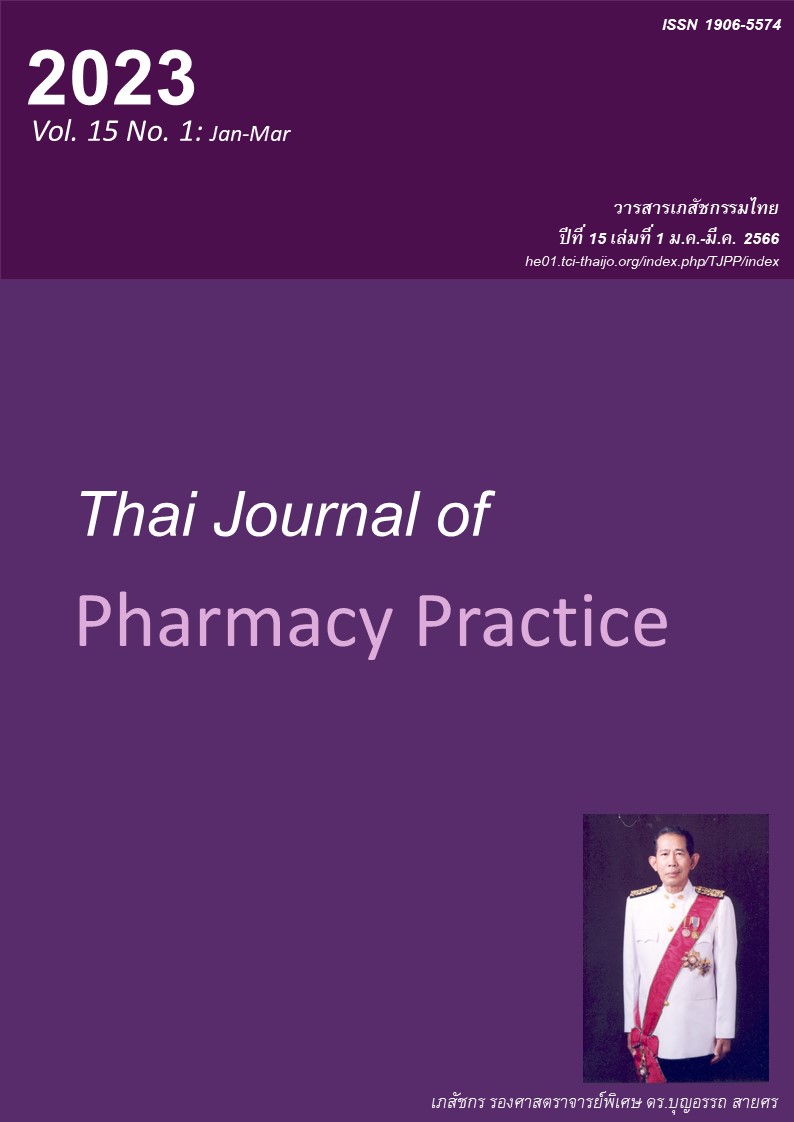การประเมินความสมเหตุผลของการใช้ยาโอเมพราโซลตามแนวทางปฏิบัติทางคลินิกในการป้องกันการเกิดแผลทางเดินอาหารจากการใช้ยาต้านการอักเสบที่ไม่ใช่สเตียรอยด์ในโรงพยาบาลชุมชนแห่งหนึ่ง
Main Article Content
บทคัดย่อ
วัตถุประสงค์: เพื่อศึกษาความสมเหตุผลและมูลค่าการใช้ยาโอเมพราโซลในการป้องกันการเกิดแผลในทางเดินอาหารจากการใช้ยาต้านการอักเสบที่ไม่ใช่สเตียรอยด์ (non-steroidal anti-inflammatory drugs: NSAIDs) ในโรงพยาบาลชุมชนแห่งหนึ่ง วิธีการ: การศึกษานี้เป็นการวิจัยย้อนหลังในผู้ป่วยที่มีอายุตั้งแต่ 20 ปี ขึ้นไปที่มีประวัติได้รับยาโอเมพราโซลชนิดรับประทานร่วมกับ NSAIDs ที่เข้ารับบริการในแผนกผู้ป่วยนอกของโรงพยาบาลตั้งแต่วันที่ 1 ตุลาคม พ.ศ. 2560 ถึงวันที่ 30 กันยายน พ.ศ. 2563 การศึกษาประเมินความสมเหตุผลในการใช้ยาโอเมพราโซลในการป้องกันการเกิดแผลในทางเดินอาหารจากการใช้ NSAIDs โดยอ้างอิงแนวทางจาก American College of Gastroenterology (ACG) ผลการวิจัย: ใบสั่งยาทั้งหมด 29,992 ใบสั่งยาที่มีการใช้ยาโอเมพราโซลในการป้องกันแผลในทางเดินอาหารจากการใช้ NSAIDs คิดเป็นมูลค่ายาโอเมพราโซล 2,876,489 บาท หรือ 95.91 บาทต่อใบสั่งยา ผลการประเมินพบว่าเป็นการใช้อย่างไม่สมเหตุผล 9,011 ใบสั่งยา (ร้อยละ 30.04) หรือคิดเป็น 759,198 บาท หรือ 25.31 บาทต่อใบสั่งยา สรุป : โรงพยาบาลมีร้อยละการใช้ยาโอเมพราโซลชนิดรับประทานไม่สมเหตุผลในการป้องกันแผลในทางเดินอาหารจากการใช้ NSAIDs เท่ากับ 30.04 และมีมูลค่ายาโอมพราโซลที่ใช้อย่างไม่สมเหตุผล 25.31 บาทต่อใบสั่งยา โรงพยาบาลจึงควรมีการจัดทำแนวทางการใช้ยาที่เหมาะสมเพื่อให้เกิดความคุ้มค่าและเกิดประโยชน์สูงสุดต่อผู้ป่วย
Article Details

อนุญาตภายใต้เงื่อนไข Creative Commons Attribution-NonCommercial-NoDerivatives 4.0 International License.
ผลการวิจัยและความคิดเห็นที่ปรากฏในบทความถือเป็นความคิดเห็นและอยู่ในความรับผิดชอบของผู้นิพนธ์ มิใช่ความเห็นหรือความรับผิดชอบของกองบรรณาธิการ หรือคณะเภสัชศาสตร์ มหาวิทยาลัยสงขลานครินทร์ ทั้งนี้ไม่รวมความผิดพลาดอันเกิดจากการพิมพ์ บทความที่ได้รับการเผยแพร่โดยวารสารเภสัชกรรมไทยถือเป็นสิทธิ์ของวารสารฯ
เอกสารอ้างอิง
World Health Organization. Promoting rational use of medicines [online]. 2022 [cited Mar 1, 2022]. Availa- ble from: www.who.int/activities/promoting-rational-use-of-medicines.
Chankunapars P, Boonyarit P, Srisuphan V, Leung ruangrong P, Prapaso N. Service plan: Rational drug use. Nonthaburi: Ministry of Public Health; 2016.
Shayakul C, Pisonthi C, Wananukul W, Bunupuradah P, Kanjanarat P, Kittiyot Y, et al, editors. Rational drug use hospital manual. Nonthaburi: The Agricultural Cooperative Federation; 2015.
Rahme E, Joseph L, Kong SX, Watson DJ, LeLorier J. Cost of prescribed NSAID-related gastrointestinal adverse events in elderly patients. Br J Clin Pharmacol 2001; 52: 185–92.
Hunt R, Lazebnik LB, Marakhouski YC, Manuc M, GN R, Aye KS, et al. International consensus on guiding recommendations for management of patients with nonsteroidal anti-inflammatory drugs induced gastropathy-icon-g. Euroasian J Hepatogas troenterol 2018; 8: 148-60.
Varavithya V, Tirapat C, Rojpibulstit P, Poovichaya sumlit P, Prasert V, Vatcharavongvan P. Potentially inappropriate medication use and the hospitalization rate among Thai elderly patients: a retrospective cohort study. Eur J Clin Pharmacol 2022; 78: 1-28.
Chia CT, Lim WP, Vu CK. Inappropriate use of proton pump inhibitors in a local setting. Singapore Med J 2014; 55: 363-6.
Sattayalertyanyong O, Thitilertdecha P, Auesomwang C. The inappropriate use of proton pump inhibitors during admission and after discharge: a prospective cross-sectional study. Int J Clin Pharm 2020; 42: 174-83.
Chariyawet P, Dilokthornsakul P. Omeprazole over use and is financial loss in a community hospital. Thai Journal of Pharmacy Practice 2018; 10: 437-48.
Lanza FL, Chan FK, Quigley EM. Guidelines for prevention of NSAID-related ulcer complications. Am J Gastroenterol 2009; 104: 728-38.
World Health Organization. ICD-10. International statistical classification of diseases and related health problems 10th revision (ICD-10) [online]. 2019 [cited Oct 1, 2021]. Available from: icd.who.int/brow se10/2019/en.
Omeprazole. In: DRUGDEX [database on the Internet]. Greenwood Village (CO): IBM Corporation; 2021 [cited Oct 1, 2021]. Available from: www.micro medexsolutions.com.
Khan MA, Howden CW. The role of proton pump inhibitors in the management of upper gastrointesti- nal disorders. Gastroenterol Hepatol 2018;14:169-75
Thai Neurogastroenterology and Motility Society. Thailand GERD guideline 2020. Bangkok: Prinable; 2020.
Gastroenterological Association of Thailand. Thai land consensus on Helicobactor pylori management 2015. Bangkok: Concept Medicus; 2016.
Pittayanon R, Leelakusolvong S, Vilaichone RK, Roj borwonwitaya J, Treeprasertsuk S, Mairiang P, et al. Thailand dyspepsia guidelines: 2018. Neurogastroen terol Motil 2019; 25: 15-26.
Doungngern T, Ngorsuraches S. Efficacy and safety of proton pump inhibitors. Nonthaburi: Akson Gra- phic and Design; 2012.
Scheiman JM. The use of proton pump inhibitors in treating and preventing NSAID-induced mucosal damage. Arthritis Res Ther 2013; 15(Suppl 3): S5.
Strategy and Planning Division Ministry of Public Health. Key performance indicator 2021 [online]. 2021 [cited Oct 10, 2021]. Available from: bps.mop h.go.th/new_bps/kpitemplate2564.
Kerkoon P. The evaluation of prescribing omepra zole in khlongluamg hospital. The Government Pharmaceutical Organization 2020; 46: 17-22.
Chutimanukul P, Wannathong P. Review of omepra zole prescribing in Angthong hospital. Thai Journal of Clinical Pharmacy 2020; 26(2): 1-12.
Gwee KA, Goh V, Lima G, Setia S. Coprescribing proton-pump inhibitors with nonsteroidal anti-inflammatory drugs: risks versus benefits. J Pain Res 2018; 14: 361-74.


